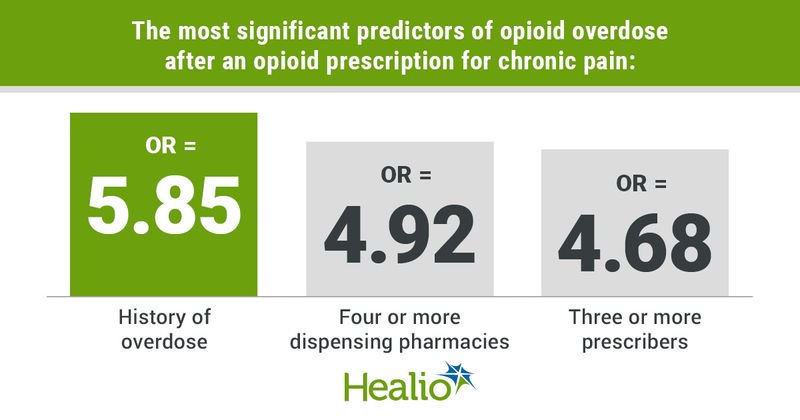Study identifies 10 predictors of opioid overdose after prescription for chronic pain
Key takeaways:
- Predictors included depression, a history of overdose and having multiple prescribers or pharmacies.
- However, evidence alone is not enough to guide decision-making for pain management, researchers said.
Researchers identified multiple predictors of opioid overdose after an opioid prescription for chronic pain in a new study published in CMAJ.
According to Li Wang, PhD, an associate professor in the department of anesthesia at McMaster University in Cananda, and colleagues, “several systematic reviews have explored predictors for fatal and nonfatal opioid overdose following prescription for chronic pain.”

However, these reviews were hampered by limitations that included a “lack of statistical pooling of measures of association, inadequate assessment of risk of bias [and] outdated searches,” they wrote.
The researchers addressed these limitations through a systemic review and meta-analysis of 28 studies that explored predictors of both fatal and nonfatal opioid overdoses.
Overall, the combined sample comprised 23,963,716 patients from the United States, United Kingdom and Canada. Patients had a median age of 52 years, and 52% were women.
The predictors that were supported by moderate-to-high certainty evidence included:
- a history of overdose (OR = 5.85; 95% CI, 3.78-9.04);
- four or more dispensing pharmacies (OR = 4.92; 95% CI, 4.35-5.57);
- three or more prescribers (OR = 4.68; 95% CI, 3.57-6.12);
- prescription of fentanyl (OR = 2.8; 95% CI, 2.3-3.41);
- current substance use disorder (OR = 2.62, 95% CI, 2.09-3.27);
- an opioid dosage of 90 mg or higher (OR = 2.57; 95% CI, 2.08-3.18);
- depression (OR = 2.22; 95% CI, 1.57-3.14);
- any mental health diagnosis (OR = 2.12; 95% CI, 1.73-2.61);
- bipolar disorder (OR = 2.07; 95% CI, 1.77-2.41); and
- pancreatitis (OR = 2; 95% CI, 1.52-2.64);
The absolute risks among patients with these predictors ranged from two to six per 1,000 for fatal overdoses, and from four to 12 per 1,000 for nonfatal overdoses.
The researchers also identified what they called “smaller-to-trivial” predictors of overdoses, which included diabetes, hypertension, liver disease, tobacco use, the number of naloxone prescriptions and white race vs. other races and ethnicities.
They highlighted that two of the largest predictors included having multiple prescribers and dispensing pharmacies, “both of which have been linked to diversion and opioid use disorder.”
“Prescription drug monitoring programs have been developed to address this issue, but their effectiveness in reducing opioid-related harms is uncertain,” they wrote.
Wang and colleagues pointed out that evidence alone is not sufficient to guide clinical decision-making for chronic pain management, “which also requires consideration of individual patient values.”
Still, “our findings should prove helpful for conveying risks of overdose to patients when deciding whether to start a trial of opioids for chronic pain, and will facilitate evidence-based, shared decision-making,” they concluded.
References:
- Predictors of opioid overdose after prescription for chronic pain. https://www.eurekalert.org/news-releases/1005194. Published Oct. 23, 2023. Accessed Oct. 26, 2023.
- Wang L, et al. CMAJ. 2023;doi:10.1503/cmaj.230459.

